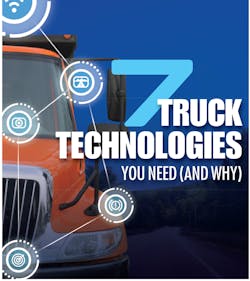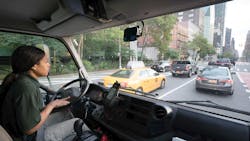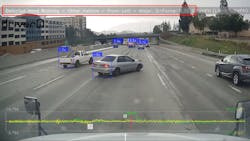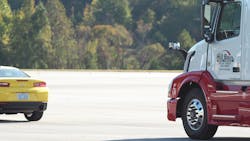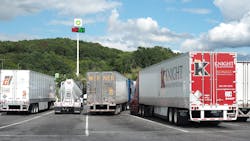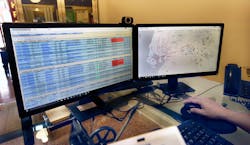As anyone who’s been to trucking conferences knows, there’s an almost endless list of add-ons that fleets could put in their trucks if they wanted. Many innovative companies are producing credible technology and related devices—today often incorporating both hardware and software—that plug into those trucks from every angle, claiming to offer advantages in the day-to-day routines of fleet and trucking operations.
That’s partly because it’s an extremely varied industry to be in, really encompassing a multitude of sub-industries, with so many types of fleets facing their own complexities and challenges in doing business. Technology is finding ways to make it easier, quicker, more accurate, less taxing, safer or safeguarded, sometimes bringing sweeping industry change with it.
The fundamental lure is that it’s going to make life better for fleets and drivers, but that’s not necessarily what leads fleets to make an investment decision. Moving freight and goods or getting work done with vehicles can be a highly competitive proposition, frequently with very thin margins, so the pitch for technology boils down to this: does it make your fleet more competitive?
For our “must-have” list, we focused on some key add-ons beyond your basic fleet management/telematics product. We looked at how using them can make your fleet more competitive—or, turning that around, if you don’t have them on your trucks, how they could give an edge to your competition.
Note that using various technologies isn’t a simple decision. Fleets have a very expensive asset in their trucks, and sometimes have a lot of them. Equipping trucks with this or that technology fleet-wide can take years, and it often requires installation and maintenance. So that means time, which means money; it’s also why tech companies are getting more of their wares installed or installable right at the truck OEM’s factory.
Truck add-ons also require an up-front investment, of course, and fleet managers, operators and owners want to see that it’s worth it. There’s got to be return on investment—at least in theory, but better if it’s black-and-white savings viewable as “before” and “after” installation—to any technology. In most cases, these things are optional.
Coupled with the time it takes to equip a fleet, the swift pace of technological advancement in the 2010s has also presented a problem. We’ve reached an age, to quote futurist Jim Carroll, when things are progressing so quickly that technology effectively can arrive to market obsolete.
So fleets don’t want to invest in systems with a life cycle like a smartphone, where they’ll get something installed and have drivers trained to use it only to have to turn around, replace everything and start over. For that reason, we selected technologies that have been maturing for years, including dynamic routing software, forward-looking camera systems, driver scorecards, collision mitigation technology, electronic logging devices, trailer tracking, and temperature tracking/record keeping.
1. Dynamic Routing
In trucking and fleet operations, you’re often moving goods or workers from point to point, delivery to delivery. The route you take to do it is everything. Dynamic routing can add in adjustability and data to inform the paths taken, especially with traffic and weather information that today truly can get close to that often-made promise of “real time.”
You can trim out unnecessary miles and find a quicker route, or map around a traffic backup or major collision with freshly updated GPS info. Or, depending on the nature of the business, dispatchers might be able to fold in additional stops to increase route density and decrease the distance traveled to each next delivery or pickup point. Dynamic routing software is getting smarter and can even do much of this for you, which amounts to automatic optimization and money savings.
All of that shaves off time and cuts down on fuel use, both of which are major cost items for a fleet. Getting better trip-planning information to optimize truck routes every day and every time just makes good business sense. It can help keep your drivers and equipment utilized, costs better controlled, and customers happier as your service levels are maximized as well, which contributes to your company’s reputation and ability to land future business.
To the point, though, “dynamic” means this isn’t cast in stone, but rather is a flexible technology. Fleets have been finding their own ways to use it, and a recent example was taking place in the run-up to Halloween. Hershey’s—officially the Hershey Co.—happens to see a significant spike in its product sales at that time of year and wants that wave to surge as high as possible.
The company uses Verizon Telematics software not only to route deliveries in the more typical fashion, but to optimize where it sends its sales team. “We worked together as a team at the end of the day to say, ‘How do we deploy our 1,200 individual sales force to the right stores at the right time?’” explained Craig Stevenson, manager of retail development at Hershey’s.
Prior to using the routing software, Hershey’s had to use “several different applications” to monitor where sales reps were going every day, but the Verizon routing software has simplified that considerably.
Hershey’s uses an in-house sales force rather than outsourcing. Dynamic routing allows Hershey’s to minimize drive time for sales reps and maximize their time at best-selling locations. “We needed internal software that can adapt and be agile to meet our needs,” Stevenson said. “Some of the features that really drew us to the routing product were route optimization, territory planning, and more importantly, the ability to forecast.”
Companies like Hershey’s are finding that using technology to optimize their operations helps them keep up with the evolving retail landscape, where e-commerce giants such as Amazon have been finding new ways to optimize inventories and reach customers better and faster.
2. Forward-looking Camera Systems
In-cab camera systems have been around for some years now and established themselves as the familiar “dash cam.” And they’ve been getting better and better in terms of quality during that time.
Vehicle video systems have tracked along with the evolution of digital cameras generally, which have seen big improvements in image processing, usability in low light/nighttime, and high-definition image capture as memory has ballooned storage capacity while getting evermore miniscule in size.
Probably first and foremost, the reason fleets implement video in their trucks is to defend the fleet and driver in case of collisions and potential phony insurance claims. For one thing, those looking for a payday can make a false claim or even try to run into a truck, knowing that fleets can be a nice, juicy target.
The other danger to trucks out on America’s roadways is more pervasive: public perception. Studies from the Federal Motor Carrier Safety Administration and other government agencies have shown that when heavy trucks and passenger cars collide, it’s the passenger car driver’s fault a convincing majority of the time at about 70% or higher. But when onlookers and the public see such a crash, they tend to assume it was “that big truck’s fault.”
So fleets and trucking companies can end up being the ones to pay when they’re taken to court, even when their trucks weren’t at fault, and there are also the legal fees to consider in fighting such claims. Forward-facing cameras can help show the truth of the matter in collisions and save the company the costs and “black eye” of being sued.
Fleets like Tennessee-based Averitt Express and Knight-Swift Transportation based in Phoenix have recently added or upgraded video systems in their trucks for these reasons. But it’s important to note that today’s video technology is doing much more than just using accelerometers or telematics-sourced events like hard braking to trigger possible adverse event video for review.
Companies like SmartDrive are doing more with things like data analytics, advanced scene recognition, and, yes, using more cameras than just one facing forward. For example, SmartDrive is launching a SmartSense system early next year that will help combat distracted driving by using a camera to monitor trouble signs like drivers talking on cell phones while operating a truck.
And Lytx, another well-established player in this space, will offer Lytx Video Services in the first quarter of 2018. One of the product and system’s functions allows fleets to stream live video from an outward-facing camera when needed, perhaps for times like when a truck arrives at a congested construction site. The back office can also go in and retrieve video long after it’s been recorded to verify a delivery was made, for instance, or get evidence to learn about many matters that can lead to disputes—not just collisions.
3. Driver Scorecards
Here’s an area where technologies have begun to overlap and complement each other. What’s evolved as driver “scorecarding” or “gamification” actually goes back quite a ways: already by the later 2000s, fleet management systems were harvesting telematics information to help show where trucks were having problems in their operation.
These were the infamous and somewhat clichéd drummings of bad driving behaviors such as hard braking and acceleration. They could indicate reckless driving that can lead to accidents and also cause greater wear and tear on the truck, resulting in increased maintenance costs. Many a fleet manager held meetings with drivers to read off the weekly “whodunit” rap sheet.
The idea has always been simple enough: whatever fuel economy your trucks get, one of the largest variables at play is a truck’s driver, who can make as much as a 20-30% difference in mpg. Bad driving behaviors can burn more fuel and lead to more frequent collisions and other costly events, and fleets can use driver scorecarding/coaching to cut down on those expenditures.
But fast forward a bit, and driver scorecards have become more sophisticated, taking a more positive approach and including smarter, more advanced functionality. A spokesperson for Vnomics, for instance, explained to Fleet Owner how its driver fuel-efficiency scoring technology acknowledges that comparing mpg of one fleet truck to another is often apples to oranges.
For driver coaching, Vnomics takes into account the type of load, the truck itself, and transmission shifting data to score a driver more accurately and fairly based on actual vs. potential mpg achievable with a given truck.
Driver coaching/scoring tech is also working hand-in-hand with truck video. Sandeep Pandya, president of truck video systems provider Netradyne, discussed how his company’s product includes 306-degree high-definition camera views to support the typical video-based functions like showing what happened in a collision. But one of the system’s claims to fame is that it incorporates artificial intelligence to automate driver scorecarding and coaching.
“It eliminates what the industry has been using to monitor driver behavior,” he said, which largely is video triggered by adverse driving events and human review. “We’re in the age of computer vision and deep learning,” he added, “and we are now able to detect and understand all of the things that are happening in the driving environment that people were relying on human reviewers for.
“And more importantly, we can now do it in real time in the vehicle,” he continued. “You’re now using camera vision to ‘see’ things that are not inertial-based, like if a driver goes through a red light, does a rolling right turn on a stop sign, came too close to a pedestrian, or is speeding 20 mph faster than the flow of traffic.”
All those things and more—including monitoring and scoring for positive driving behaviors—can be detected and analyzed automatically based on camera recognition technology. That means it’s becoming much more possible to automate driver scoring and coaching rather than piling on the fleet manager while also taking a fairer, more holistic approach.
4. Collision Mitigation Technology
Research shows that heavy trucks are overrepresented in collisions and fatalities. In a recent study, the Federal Motor Carrier Safety Administration noted that heavy trucks and buses accounted for about 4% of registered vehicles and 9% of total miles driven but were involved in 13% of accidents and 13% of overall traffic fatalities.
It’s partly due to their larger mass and size, the agency has speculated, which can easily cause serious damage to smaller passenger vehicles. Even though crash data analyses consistently show it’s the passenger vehicle driver who’s most often at fault when passenger cars and heavy trucks collide, any heavy truck collision can mean expensive insurance claims and lawsuits.
So it’s in the interests of both public safety and preserving profitability for fleets to reduce avoidable collisions to an absolute minimum. That’s particularly the case for fleets hauling fuel and other dangerous materials, since a crash can mean more damage and very expensive cleanup.
Advanced collision mitigation systems are incorporating more sensing technology to monitor for crashes of various kinds and can take emergency action to avoid them. Today’s systems also are cutting down on the number of false positives that the first such products years ago tended to give. Because of the obvious benefits they can offer if they work properly, collision mitigation systems are becoming standard on many new trucks—typically with the ability to opt out—and can be retrofitted to older trucks as well.
One of the more popular systems available is Bendix Commercial Vehicle Systems’ Wingman Fusion product, which uses radar and video to monitor the road ahead for obstacles and includes an electronic stability program to protect against rollovers and loss-of-control accidents. Meritor WABCO’s OnGuard system offers similar functionality, relying on short-range radar for potential obstacle detection; in late October, the company announced blind spot collision protection with its new OnSide product.
So collision mitigation technology is finding new ways to monitor more of what’s going on around a truck as well as the truck’s speed and control in various conditions, offering the ability to take autonomous emergency action if necessary. But meanwhile, other technology may offer additional ways to approach collision reduction through driver behaviors.
Drivewyze, for example, is best known for providing a bypass service that transmits truck weight and load data to participating weigh stations and inspection sites to allow truckers to drive on by. Now free as an add-on to all its customers, the company has added Driver Safety Notifications to alert truck drivers when they’re coming up on “trouble zones.”
Drivewyze worked with law enforcement agencies to identify locations that have a higher need for safety, which might include something like a specific highway off-ramp where vehicle speed contributes to a high-collision intersection. Doug Johnson, director of marketing at Drivewyze, noted that beta testing also was done in conjunction with carrier J.B. Hunt to build, test, and deploy Driver Safety Notifications.
Knowing from its weigh station bypass service that in-cab messaging can influence driver behavior, Drivewyze “understood that we could offer the opportunity to get the attention of drivers to slow down at key locations,” Johnson said.
5. Electronic Logging Devices
It’s not an option but a requirement that as of December 18, nearly all U.S. interstate commercial trucking operations will need electronic logging devices, or ELDs, to be doing business legally. Older units called automatic onboard recording devices, or AOBRDs, are being grandfathered out over the next two years, but serve a similar function.
And that would be electronically tracking and recording commercial truck drivers’ hours of service (HOS) to ensure drivers are operating these vehicles within the requirements and restrictions set by the Federal Motor Carrier Safety Administration, the federal regulatory body. Some owner-operators and small-fleet drivers have bristled at the idea of electronic logs, often claiming they needed to operate beyond HOS limits in order to stay in business in a highly competitive industry.
Yet others in the industry argue exactly the opposite: that electronic logs will actually make fleets and trucking companies more competitive. Note that this is an industry that frequently flirts with 100% driver turnover, meaning a fleet might replace all of its driver workforce each year. It’s a tremendous cost.
Steve Rush, owner of New Jersey-based Carbon Express, blames that turnover partly on the evolution of the truck driver job since the industry was deregulated decades ago. He noted that his fleet has been using electronic logs throughout the 2010s and chose to go with Omnitracs products.
With a deep trucking pedigree himself, Rush recalled driving long before the days of electronic logs, once with a job driving a truck 19 hours a day Monday-Friday, 14 hours on Saturday and four on Sunday. “I had so many accidents,” Rush said. “I rolled my first truck at 23—I fell dead asleep.” He also spoke about cheating in keeping paper logs as a driver.
After starting his own business, Rush said he “saw the light” around 2008, a time when his drivers were getting caught with HOS violations. But the company decided at that point to “do things right,” he said, and it took nearly two full years to change the company culture and switch over entirely to e-logs. Eventually, the change would double the fleet size and helped improve drivers’ lives immensely.
“I had to change first, and then everybody else behind me had to change,” said Rush. The switch at his company included a move from sleepers to day cabs; his trucks still make cross-country runs, but drivers sleep at motels when they need to.
“In the ‘70s, I was so proud to drive a truck,” Rush said. “But we went from a job that people actually wanted to a job that is considered a job of last resort.” He added that electronic logs “are not the end-all, do-all, but they’re going to go a long way” toward getting back to the dignity that truck drivers had decades ago.
“It’s the greatest tool that we’ve ever had to enforce all the things that we need to enforce,” Rush said. “It’s my hope that this is going to force us to do things right.”
6. Trailer Tracking
Trailer tracking technology can make it considerably easier to locate and manage the utilization of these assets.
When you think of asset tracking as it applies to truck trailers, the first thing that might come to mind is loss prevention. Adding GPS tracking and a system to monitor what’s going on with your trailers could warn a fleet if those trailers are in high-theft areas, for example, or track a trailer that’s stolen.
Better visibility of these expensive assets makes solid business sense, just as it does for tracking and managing tractors. And right there, we’ve hit on the bigger reason to add trailer tracking technology to your fleet.
Trailer tracking doesn’t only involve a GPS transponder that mounts physically to the trailer. It also provides yet another wireless sensor in the Internet of Things, and that means a trailer-tracking device can provide data to be fed into a fleet management system.
As usual, once Big Data is factored in, there’s more that can be done. For example, MiX Telematics offers its MiX Asset Manager, which can track a shipping container just as easily as a trailer. The company said the technology can make managing assets much easier, such as billing for a trailer that’s rented out.
Technologies and services are combining in trailer tracking to do more. BlackBerry, which launched its Radar tracking system last year, provides analytics that along with its tracking device can allow a fleet to manage trailer utilization, maintenance and more. Late last year, BlackBerry entered into a sales partnership with fleet graphics services provider Modagrafics.
“We found this is a further extension of what we do,” Paul Pirkle, president and CEO of Modagrafics, told Fleet Owner. With trailer tracking, “we can look at utilization, productivity, dwell time—all the stuff that our customers care about.
“They can look into their trailers and see how they’re being used, where they’re being used, and whether they’re full or empty,” he continued. “And where we’re thinking of going from here is that this could have a marketing implication.”
For example, he explained, Modagrafics might work with a fleet to launch a local sales campaign that includes specific graphics on trailers, and BlackBerry’s Radar tracking system could monitor where those trailers go. The fleet, in turn, could watch for an uptick in sales around those locations.
Trailer tracking can also eliminate guesswork when it comes to maintenance, which is a benefit Spireon Inc. points to with its FleetLocate asset management solution. Today’s systems can attach maintenance data and records to a trailer, allowing the fleet to visualize what’s been serviced and what hasn’t and make better, more consistent maintenance and inspection plans. Fleets can also make informed equipment purchasing decisions when they have good visibility and utilization of their trailers.
And, of course, the others in the fleet often trying to find trailers are the drivers, who may find themselves puttering around a yard trying to locate a trailer among hundreds of others. Again feeding into a fleet management system, a trailer-tracking device can streamline that process by giving the driver an easy “X marks the spot.”
7. Temperature Tracking/Record Keeping
This is another category of technology that’s become mandatory for many carriers. As part of the Food Safety Modernization Act, those involved in transporting human and animal food including shippers, carriers and receivers must follow best practices for sanitary transportation.
It requires things like properly refrigerating food, cleaning vehicles between loads to prevent contamination, and protecting food during transportation. Small businesses with less than $500,000 in average annual revenue have until April 2018 to comply with the new rules, but Jerry Robertson, chief technology officer at fleet management company BOLT System, argues there are real business advantages to compliance right now.
For one thing, shippers are going to want to do business with carriers that have this technology, he told Fleet Owner. “In their contracts with carriers, shippers need to be able to show they can comply with the new rules and provide documentation that as a truck comes into a facility for a pickup—whether it’s milk on a farm or a frozen product coming out of a manufacturing plant—the correct temperatures were preset in the trailer to accommodate that kind of food,” Robertson noted.
Thus temperature-tracking technology may essentially become a prerequisite for a carrier to continue doing business, but transporting food also has its nuances. “Say there are different compartments in the trailer,” Robertson noted. “Particularly if it’s a grocery-type load where you’ve got frozen products and fresh goods, all of these have different temperature settings.”
Most refrigeration units today now have technology built in that can not only show the temperature within the trailer but can send results to the fleet management platform with GPS positioning, he explained. The fleet management system can match up that information with the load requirements and provide documentation of temperature at pickup and delivery—and also monitor for problems in between.
“One of the challenges in there is that you’re going to open and close those doors on the trailer,” Robertson noted, “and you can let in a lot of hot air in a hurry. We need to be able to see those temperatures, and if there’s a problem, we can tell the driver he’s got to pull over and fix it.”
An early warning of temperature trouble could help save a load. Temperature tracking can also provide documentation of proper handling to protect those involved, for example, if people were to get sick from food that’s delivered.
“The shipper is going to really want carriers to have this technology to be able to provide the support and documentation,” Robertson contended. “So you need this technology not only to protect you from losing the load itself, which can be very costly, but even much more so from any litigation that could be involved.”
Meanwhile, being able to show temperature tracking and documentation could also help in the event that a reefer truck is pulled over or inspected. It never hurts to have some evidence showing you’re doing things right, Robertson pointed out.
“I would tend to believe that as we move forward, this [technology] will be one of the things carriers use to market themselves,” he said.
About the Author
Aaron Marsh
Aaron Marsh is a former senior editor of FleetOwner, who wrote for the publication from 2015 to 2019.
